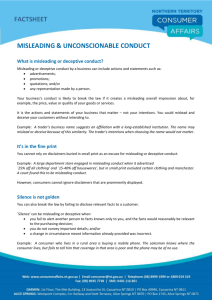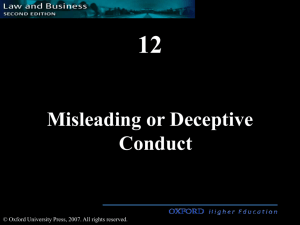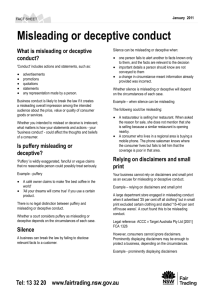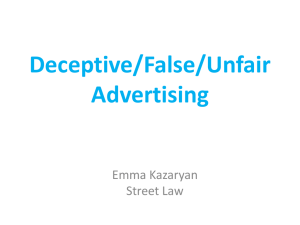201147151517840
advertisement
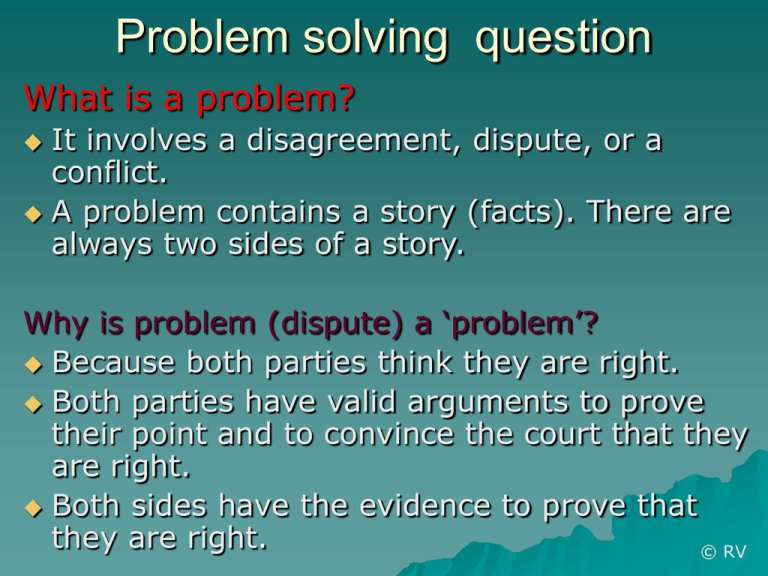
Problem solving question
What is a problem?
It involves a disagreement, dispute, or a
conflict.
A problem contains a story (facts). There are
always two sides of a story.
Why is problem (dispute) a ‘problem’?
Because both parties think they are right.
Both parties have valid arguments to prove
their point and to convince the court that they
are right.
Both sides have the evidence to prove that
they are right.
© RV
Problem solving question
Problem-based question typically involves
consideration of a specific fact scenario that
requires an assessment of the legal rights
and liabilities of the parties involved in the
problem.
There may be a number of issues involved in
the problem question (i.e. whether a legally
binding contract has been formed between A
and B; whether A breached the implied
condition of…..under Div 2, Part V of the
TPA; whether A can enforce the exclusion
clause against B; Whether A Pty Ltd has
engaged in misleading or deceptive conduct
when dealing with B; whether A has engaged
in unconscionable conduct when dealing with
B).
Problem-solving format
The key elements of an effective answer
to a legal problem question are the
identification of the relevant legal
issues, explanation of the relevant legal
principles, application of these legal
principles to the given factual scenario.
A logical and persuasive application of
law should provide a conclusion that is
supported by the balance of legal
authority.
Thus, a problem solving answer involves
4 steps.
© RV
Steps to problem-solving
Issue
Relevant legal principles/Rules
Application
Conclusion
This method is called IPAC or IRAC.
Some authors call this method MIRAT (involving
Material facts, Legal Issues, Legal Rules,
Application and Tentative conclusion).
Note: Whatever method of problem-solving you
use, practice on it and get used to its format.
[I prefer IPAC method. It is easy to remember
and practice on. The only way to get used to it
is to practice on it. So, practice, practice and
practice. Use problems from your textbook.
© RV
Steps to problem-solving
Issue: What is the legal issue involved in this
case?
Legal principles: What does the law say/state
on that issue?
Application: How does the law apply to the
facts of this case?
- What are the arguments of both parties
(plaintiff and the defendant)?
- Whose argument seems weighty?
- Whose argument is likely to succeed?
Conclusion: What is the likely outcome of
© RV
this case?
Steps to problem solving
What is the legal issue involved in this dispute?
Which legal principles are relevant to the issue and
Where do these principles come from?
How do these legal principles apply to this case and
what could be the arguments from both sides?
Considering the arguments from both sides, what
would be the likely outcome of the case then?
In a nutshell, remember: what, which, where, how
and then.
If you do not address these questions, your answer
may be incomplete or lacking legal analysis.
Steps to problem-solving
Issue:
Has a legally contract been formed
between A and B?
Principles: A legally binding agreement
contains certain elements:
- Offer & Acceptance (legal requirements)
- Intention (commercial and family
agreements)
- Consideration (executed or executory)
- Certainty of terms
{It is important that you support the legal
principles by relevant case law}
Steps to problem-solving (cont…)
Application:
Whether the contract was intended to be legally
binding. Explain how.
- Whether a legally valid offer made by A to B or whether
it is an invitation to treat.
- Whether final and unqualified assent to the terms of
the offer occur between parties. Explain how.
- Whether consideration was paid by the parties. Explain
how.
- Whether the terms of the contract are certain and firm.
If not, why not. If yes, explain how.
- Determine whether a legally binding contract has taken
place. If not, why not (i.e. what factors reveal that
there is no contract?). Do not forget the defendant’s
arguments.
Conclusion: State whether a legally binding contract
exists/or does not exist between parties. Do not justify
your conclusion by engaging in further arguments.
-
Steps to problem-solving
Issue: Whether Bundy Pty Ltd engaged in misleading deceptive conduct.
Relevant legal principles: Section 52 of the Trade Practices Act 1974 (Cth)
(TPA) states that ‘a corporation shall not engage in conduct that is
misleading or deceptive or like to mislead or deceive’.
Corporation, trade or commerce, engage in conduct have been defined in
s. 4 of the TPA (define the terms and support them with relevant case
law).
Misleading or deceptive conduct has not been defined in the TPA,
however, the federal court in such and such case defined misleading or
deceptive conduct as…… (mention the name of the case here, Brown v
Jam Factory (1981) 53 FLR 340)
Remedies for breach of s. 52 include damages (s. 82); injunction (s. 80);
Disclosure of information or corrective advertising (s. 80A) and Ancillary
orders such as rescission and variation of contract (s. 87)
Note: Legal principles may come from common law, statute law or from
equity. All these, if relevant, have to be mentioned in the legal principles.
Application: How does the pre-conditions of s. 52 apply to the facts of the
case? What are the arguments of the plaintiff? What are the arguments of
the defendant? What remedies may be available to plaintiff if he/she
succeeds in his/her argument against the defendant?
Conclusion: Bundy Pty Ltd has engaged in misleading or deceptive conduct.
[Conclusion should be brief, clear and to the point. Do not sit on the fence]
© RV
References
Glenda
M Crosling and Helen M
Murphy, How to Study Business Law,
3rd edition, Sydney: Butterworths,
Chapter 9.
Sally Anne Fraser, How to Study Law,
LBC, 2nd edition.
Your textbook, “How to Write a Good
Answer” and “How to Plan and
Structure a Good Answer”.
© RV
